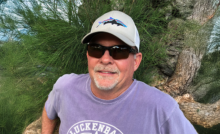Overseeding–darned if you do and darned if you don’t
Darned if you do and darned if you don’t.
That’s overseeding for you. If there is ever an unnecessary task in golf course management that is by most accounts necessary, it’s winter overseeding.
To put it in another perspective, if the love of money is indeed the root of all evil, then overseeding is a necessary evil … an agronomic procedure aimed more at wooing winter play in the southern environs of America than for any meaningful enhancement of turf health.
Overseeding is most commonly done by courses that use bermudagrass, which goes dormant in winter. Courses that overseed will prepare their bermudagrass for overseeding through a combination of processes that include aeration, verticutting and scalping. The ryegrass seed is then distributed on top of the bermudagrass and nurtured for several weeks as it germinates and grows in the upper profile of the bermudagrass that is entering dormancy. In late spring as the weather warms up, the golf course superintendent will encourage the bermudagrass as it comes out of dormancy and the ryegrass is loosing its ability to withstand the warmer weather.
Many courses either close during overseeding or offer discounted greens fees during these periods because of the disruption to play that overseeding causes.
It could also be said that overseeding is one of the more visible signs of the state of modern golf and the care of its venues. As the playing and paying customers flee the northern climes beset by winter, they are truly in search of the green.
Thus, superintendents across the nation’s southern tier of states avoid the brown —
dormant bermudagrass — and perpetuate the green by overseeding with a cool-season grass.
To call it a cosmetic practice would be accurate, but also simplistic. The economic viability of thousands of golf courses and the job security of those who manage them loom beneath the pretty, green surface.
The key fact is, golf courses that rely on winter play to be a successful operation must, for better or worse, overseed to achieve that level.
Nowhere in the country is this more evident than in the Southwest, where scores of new facilities spring up every year to accommodate throngs of golf-hungry customers from the north.
Many issues have been addressed along the way, such as impact on play, costs, water usage and chemical removal of the ryegrass in transition because of its tendency to hang on too long in the Southwest.
For those superintendents and facilities that choose not to overseed , they often find their course provides variety and challenge as the seasons change. Beyond aesthetics, overseeding does provide better turf conditions in the winter. Without it, many courses have to combat wear and compaction problems caused by player and golf car traffic. However, they have their reasons for avoiding overseeding:
- Water conservation … Dormant bermudagrass uses far less water than overseeded perennial ryegrass.
- Uninterrupted play in the fall … Courses avoid the disruption and course closure often required for overseeding.
- No spring transition problems … Without competition from overseeded ryegrass, bermudagrass can green up earlier in the spring.
- Ease of weed control … It is easier to control annual bluegrass and weeds in dormant bermudagrass with selective and non-selective herbicides.
- Sustain a stronger strand of warm season grasses … Many courses experience a gradual decline of bermudagrass density after years of renovation and overseeding. Without overseeding, courses can build a strong strand of bermudagrass throughout the fall that will provide better density and playing quality the following spring and summer.
- Lower maintenance costs … Courses that do not overseed may save $750 to $1,000 per acre by not purchasing seed. Overall costs are lower for water, fertilizer and mowing; plus there is less wear on equipment.
On the other hand, dormant bermudagrass has produced golfer complaints based on its lack of green color; worn areas, especially in high traffic zones; and slow recovery from divot damage. Non-agronomic advantages to managing dormant bermudagrass include the subtle changes in playing quality during the winter. Tee shots often roll farther, different clubs and types of shots are required and hazards that are usually unreachable may now come into play. All of this adds up to a course that provides variety and challenges as the seasons change.
It’s the age-old question for golf facilities, to overseed, or not to overseed? The answer, however, is not cut and dried.
Key points:
- Overseeding is most commonly done by courses that use bermudagrass, which goes dormant in winter.
- Many courses either close during overseeding or offer discounted greens fees.
- Beyond aesthetics, overseeding with ryegrass can provide better turf conditions in the winter.
- Dormant bermudagrass has produced golfer complaints based on its lack of green color;worn areas, and slow recovery from divot damage.
- By not overseeding, courses can sustain a stronger strand of warm-season grasses.
- Without competition from overseeded ryegrass, bermudagrass can green up earlier in the spring.
Recent Posts
Foley Company attains GCSAA Silver Partner Status
Foley Company, a leader in turf equipment innovation and technology, affirms its support of the…
Harrell’s continues longstanding support of the GCSAA Foundation
Harrell’s LLC, a leading distributor of customized agronomic products for turfgrass since 1941, has donated…
City of Orlando Announces New State-of-the-Art Driving Range at Dubsdread Golf Course
The City of Orlando is excited to announce the construction of a brand-new, state-of-the-art driving…
Discover Puerto Rico for Great Golf Trips and After-Round Activities, Amenities
Golfers cannot live by the game alone which is why Puerto Rico provides the perfect…
Q&A with a Multi-talented Golf Course Architect – Part 2: Making the Rounds – Installment 39
This column features recollections of the author’s 37 years as a golf writer. These installments…
With LOKSAND, Bunker Faces & Edges ‘Aren’t Going Anywhere’
LOKSAND Global has announced North American availability of the stabilization product LOKSAND (www.loksand.com), in addition…



